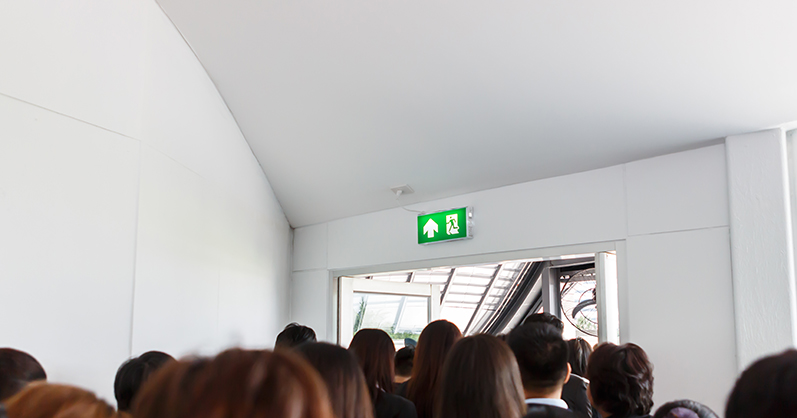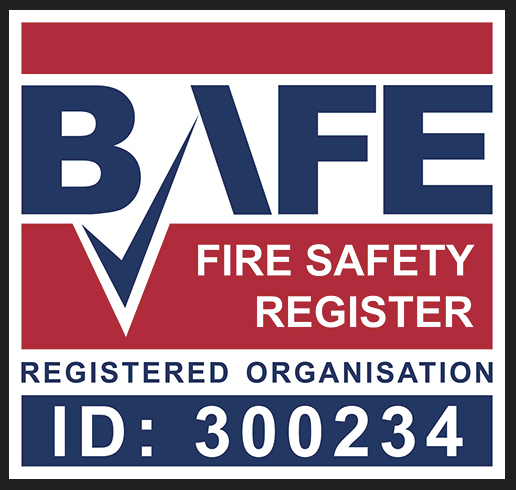Industry Articles

Everything you need to know about emergency lighting
When a fire occurs and the power supply fails your first plan of action will be to evacuate as quickly and safely as possible. That’s why having effective emergency lighting is of critical importance. Without it, finding your way out of a building, no matter how familiar, will be much harder.
Further to that, not only is emergency lighting extremely useful, but it is also required by law as part of the Regulatory Reform (Fire Safety) Order 2005.
What is emergency lighting?
When an emergency causes the lights to go out, emergency lighting will stay on to direct you safely to the nearest exit.
After a power outage, emergency lighting will stay on for up to 3 hours to ensure that anyone in the building has long enough to find their way out. Once the power is back on, the lights will then recharge themselves so they can continue to work should they be needed again.
You will find emergency lighting above exit signs,fire safety equipment, exit doors and in escape routes and stairways.
When a fire occurs you never know who will be in your building, and the placement of this lighting is carefully thought out. This is to ensure that – even if you have no knowledge of the building layout – you will be able to find your way to an exit safely.

Why is emergency lighting important?
All regulations required for emergency lighting can be found in The Regulatory Reform (Fire Safety) Order 2005. More specifically, article 14 states that “emergency routes and exits requiring illumination must be provided with emergency lighting of adequate intensity in the case of failure of their normal lighting.”
It is also outlined by the code of practice for emergency lighting, otherwise known as BS 5266-1, that the person responsible for the fire safety in their building (known as the “responsible person” or “RP”) has to be able to demonstrate that the hardware and maintenance of their fire safety systems are adequate to protect the building’s occupants.
Emergency lighting is an essential step in providing effective fire safety at your premises.
It is of particular importance for commercial and industrial buildings. Examples include care homes, hotels, offices, and factories that have a number of people coming in and out of the building and a more complex layout.
When a fire breaks out and the lights go off it is natural to feel panicked and with thick smoke filling the room, finding your way out of the building without effective lighting guiding you can be difficult. Without emergency lighting, it is near impossible.
The responsible person should also consider the possibility of obstacles and debris in the evacuation route. This is why escape routes should be checked regularly but also highlights the importance of emergency lighting.
Without a clear view, these can cause real injury and hinder your evacuation further. Emergency lighting will illuminate the way, helping to highlight these dangers so any injuries can be avoided.
Dorset Fire Protection has been offering the installation and maintenance of emergency lighting in Dorset and West Hampshire for years. If you require emergency lighting, we’re confident we can meet your requirements.
Types of emergency lighting systems
There are four main types of emergency lighting to choose from:
- Escape route lighting
- Open area lighting
- High-risk task area lighting
- Standby lighting
Escape Route Lighting
Escape route emergency lighting is also known as bulkhead lighting and helps to provide the safest and fastest route to a fire exit. These lights are installed in the ceiling to illuminate the way, helping you to avoid obstacles.
The amount of lighting needed will depend on the area and how often it is used, so it is essential to seek expert fire safety advice in order to ensure they’re being placed as frequently as needed.
Open Area Emergency Lighting
Open area emergency lighting is also known in some countries as anti-panic lighting. The main aim of this emergency lighting is to reduce panic by providing more illumination for the occupants in the building in order for them to reach an escape route and exit safely.
This is done by placing emergency lights in open areas of the building so that when building occupants are evacuating there is as much light as possible.
High-Risk Task Area Lighting
For factories and other industrial buildings, high-risk task area emergency lighting is required. Workers conducting high-risk tasks, such as using machinery or working with tools, must be able to adequately see what they are doing in order to allow for a safe shut down of the equipment.
Without high-risk task area lighting, it can be extremely dangerous if the power goes out. The user would be unable to see clearly and this poses a risk of injury to themselves or others.
Standby Lighting
Lastly, in the event of a power cut, standby lighting can supply adequate lighting to ensure that normal activities can continue.
This is usually supplied by an emergency generator but, unlike the others, is not required by law and should only be considered depending on your building and its occupants.
As most of these emergency lights are required by law it is essential that you have an effective system in place that illuminates your escape routes clearly.
You should also consider your building and whether it requires high-risk task area lighting or even standby lighting, ensure that the necessary lighting is in place.
You can talk to the Dorset Fire Protection’s expert team to discuss the emergency lighting requirements of your premises – we’re always on hand to provide pragmatic fire safety advice.

Traditional emergency lighting vs LED emergency lighting
In recent years we have seen a subtle shift towards LED emergency lighting over the traditional fluorescent lighting used in the past. One of the main reasons for this is the drive to reduce energy consumption, but there are many more benefits.
The initial outlay for LED lighting can be more expensive than traditional emergency lighting.
However, it’s important to look further than the upfront cost and consider the cumulative savings you will make over time due to a reduction in electrical and energy costs. In fact, the upfront cost of LED lights can be regained in just a few months.
When you invest more in your emergency lighting you will see better results, as LED lighting provides a higher quality of light with none of the flickerings that you often find in traditional emergency lighting.
This is beneficial for all types of buildings and businesses as it provides a clearer illumination which makes for a smoother exit. Further to that, the need for the frequent replacement of your fluorescent tubes will also be eliminated.
Other benefits of LED emergency lighting include:
- Longer lasting
- Energy efficiency
- Better for the environment
- Directional lighting
- Cost-effective
With this in mind, it is clear to see that LED emergency lighting is the way forward and Dorset Fire Protection can install and maintain your LED emergency lighting for you, offering a 10 year guarantee on most replacement light fittings.
Who can test emergency lighting?
Emergency lighting systems should be checked both monthly and annually. Generally, both can be done by the responsible person for fire safety in the building. However, most fire safety companies will carry out an annual emergency lighting test at the same time as your fire alarm system maintenance.
The annual check usually consists of switching off the mains power supply to the lighting unit and leaving the emergency lighting illuminated for the maximum period, which is usually 3 hours. If the lights do not last for the entire testing period then the back-up battery will need replacing.
Monthly emergency lighting checklist
All emergency lighting tests require the mains supply to be switched off, so it is important to plan ahead to avoid disruption.
The monthly check can be conducted by following these steps:
- Switch off the mains to your lighting system.
- Use the specialist key switch to test lighting.
- If you do not have access to a key switch, use the fuse box instead – it should be clearly labelled.
- Go through and check that all emergency lighting is working.
- Once all lights have been checked, restore the mains supply and check that the green LED light is illuminated within the light fittings.
- All lights should be cleaned if dirty or obscured.
- With fluorescent lighting, check for significant areas of black on the lamp and replace if needed.
All fire safety tests should be logged in the fire safety logbook with any further actions required reported. Learn more in our Monthly Check of Emergency Lighting video below.
Click here to see our other fire safety videos
Summary
In the event of an emergency, will your emergency lighting guide you to safety? Whether you require the installation of new emergency lighting or the replacement of old fittings, Dorset Fire Protection offers the full emergency lighting package with a 10-year guarantee.
In fact, that’s exactly what we did for this Victorian Seaside Hotel – providing a suitable replacement LED luminaire that was not only similar to the original size and design but also cost no more than the original fluorescent luminaire.
If you’d like more information, feel free to contact us by phone on 0330 7000 555 or by email. We are located in the heart of Dorset and are primed and ready to answer your calls Monday – Friday, 8am-4.30pm.
This article was written by Gary Askew, Managing Director of Dorset Fire Protection.
He has over 20 years experience of supplying fire prevention measures and finding premium solutions.

Follow Gary on LinkedIn
Follow DFP on LinkedIn
Follow DFP on Facebook






